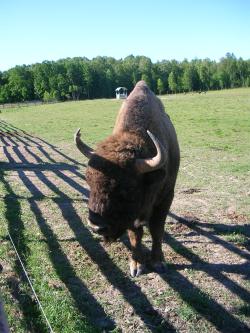Discussion

The results show that the enclosure design did have effects on the activity budget. In the naturalistic enclosures there was more movement, both walking and running than in the more barren environment. As European bison movements are correlated mainly with feeding activity and to ensure optimum use of food supply, this would be expected, as the bisons in the natural enclosure had pasture and those in barren enclosures were offered food in a way that did not stimulate movement or exploratory behaviour, i.e. in the same way and in a container.
However, even though the time spent “feeding on supplemental food sources” was significantly higher in the barren enclosures, the total time spent feeding did not differ between the two enclosure types. As the feeding routines for the bisons in the different enclosures, in addition to offering concentrates, also offered ad libitum accessibility to hay, the latter appears to fill the “free” time and possibly satisfy the natural, polyphasic feeding behaviour in these bisons in both types of enclosures.
There was also a significant difference in the amount of time “lying down” per day; however, the amount of lying down in natural enclosures could have been increased as the natural enclosures were also larger in size which made the observations during the night troublesome, as the bisons sometimes were lying far away and with the night-vision binoculars is was not distinguishable if the bisons were ruminating or not when lying down.
The result showed that the small feeding enrichment from the addition and scattering of browse had a significant effect on several behaviours in the barren enclosures. Although the browse was scattered to the degree possible, no significant increase in walking occurred, but a significant decrease of the total amount of standing was seen. The amount of eating from natural sources, which the added browse was a part of, was doubled and the eating from supplemental sources (hay, pellets) was significantly reduced. This could be due to that when given a choice between receiving free food and performing species-appropriate behaviours to acquire the same food, they choose to work.
When considering the overall change before and after the enrichment, it was a larger effect in the barren enclosures. This could implicate that this kind of enrichments is more suitable and effective in a barren enclosure as no larger effect was shown in naturalistic enclosures. Furthermore, by scattering the food could give increased activity to relatively low cost.
Conclusion
This study showed that there are differences in activity when considering barren and naturalistic enclosures and that naturalistic enclosures had a higher activity level. However, the total time spent feeding did not differ between enclosures. Furthermore, the enrichment experiment showed that adding and scattering of browse have a large effect in barren enclosures where the amount of inactivity decreased. Scattering of browse can therefore be regarded as a cheap and simple way to decrease inactivity and stimulate active foraging.
When comparing the activity in these enclosures to the wild population it is similar to what is seen in the wild during winter when supplemental food is given. However, the amount of activity doubles during the summer. These comparisons show that the patterns of activity may be specific, but that distribution of activity phases in time is modified by the season of the year and feeding system.
Responsible for this page:
Director of undergraduate studies Biology
Last updated:
05/21/09
